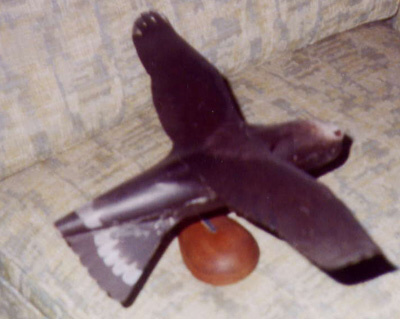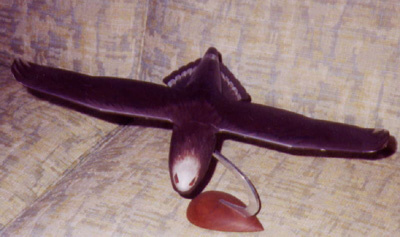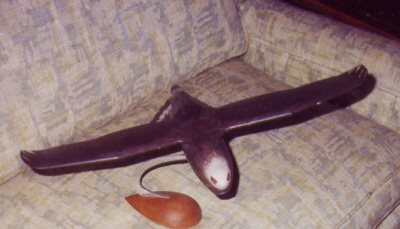During one summer, a
friend loaned us an apartment on the beach in N.J. Millie and the children
stayed up there for a month. I would fly up on weekends in an F84 Thunder Jet
fighter. To let her know when to come to Lakehurst Naval Station to pick me
up, I'd go about 20 miles to sea and head for her apartment at full speed at
a very low level then pull straight up over the house. This, of course, would
make a hell of a lot of noise and scare the hell out of anybody
that didn't see me coming. I finally quit doing that for fear of
scaring somebody to death or causing an accident.
In the meantime, back at Turner AFB
in Albany Ga. I was busy helping to develop air to air refueling techniques
for airplanes. We used T-33 aircraft. At first we had probes sticking out of
our tip tanks and the trick was to stick this probe into a cone on the end of
a hose hanging from a tanker plane. No easy task since first you had to line
the tip up with the hose, 25 feet out on a wing tip, then if you pushed too
hard the hose would loop up to the tanker and when it came back it would make
the probe bend vertical with the hose attached and there you were. Besides, if
you did fill one tank, it was very heavy and the aircraft acted very strange
with one very heavy tiptank and you still had to fill the other one. Great
fun. Progress and development did come.
In the F-84 they installed a system
that had a receiver in the wing root and the tanker plane had a boom sticking
out and down and a man in the tanker could fly the boom and also extend it.
The receiving plane now had to fly in formation with the tanker and the
boom operator would stick his probe into the receiver and pump fuel in at a
great rate. A fighter could be fully refueled in about 5 minutes. All modern
military planes, fighters, bombers, cargo and even helicopters now have this
capability.
We used these systems when we flew
our pioneering mass fighter flights across the Atlantic and Pacific oceans.
Some of the non-stop routes that we flew in F-84s were to Morocco via Bermuda
and on to England, [code named Cocoa Alpha I and II] and to England via
Iceland and Greenland [code named Longstride] and to Japan across the Pacific
but we stopped at Hawaii, Midway, Enewitoc, Guam and then Japan. [code named
Fox Peter One ]The only air to air refueling needed over the Pacific was to
Hawaii. By the way, the furthermost that you can get from any land, other than
straight down, is between the Golden Gate Bridge and Hawaii, a distance of
about 1500 miles. I planned and briefed all of these flights, flew them and
navigated them from my F-84 cockpit. The following article was published in
the Fighters In-Formation, the newspaper for Turner Air Force Base in Albany,
Georgia, dated December 50, 1954, page 3. Accompanying the article was a photo
of Capt. Meierdierck and Capt. Maggert.
|
508TH NOMINATES 2 PILOTS FOR USAF FLYING AWARD
Effective
teamwork, coupled with professional flying ability, served to
change a serious emergency into a successful landing and earned
two pilots of Hq. Sq. 508th Str. Ftr. Wg. nominations for the USAF
"Well Done" Flying Safety Award. Captains John H.
Meierdierck and Donald W. Maggert received the nomination after
jointly averting a possible major aircraft accident during the
15,000-mile transatlantic and European mission, Coca Alpha II last
October.
Capt.
Meierdierck, with his F-84G suffering complete hydraulic power
failure and a dead radio compass, was assisted to a successful
landing at Bordeaux AB, France, by Capt. Maggert, his element
leader.
To make the
situation even rough, visibility was down to less than a mile,
with ceiling of only 150 feet at the time of the landing; no CGA
radar was available at Bordeaux; the field's inner marker beacon
was inoperative; both aircraft were low on fuel.
Only the
Bordeaux outer marker beacon situated 10 nautical miles away from
the field was a usable radio aid for letdown and low approach.
Capt.
Meierdierck's difficulties had begun when his hydraulic power went
out over Madrid, Spain. He was flying number 24 position in a
flight of 24 F-84G's which were on their way from Nouasseur AB,
French Morocco, to Bordeaux. The flight was the third leg of a
training mission originating and culminating at Sturgate RAF
Station, England.
He flew the
aircraft without boosted control surfaces until becoming fatigued
from fighting the excessive control forces. He then engaged the
automatic pilot and continued on course, remaining in the vicinity
of the formation without too much difficulty because of his number
24 position.
Over
Bordeaux and just prior to entering the top of a 20,000-foot
overcast during the letdown and low approach.
He advised his
flight leader of the new difficulty and stated he would be unable
to descend into the overcast in formation. This was because,
lacking a dive break, Capt. Meierdierck would have been unable to
maintain proper separation from the rest of the formation hidden
in the overcast.
Flying on
relative radio bearings relayed by Capt. Maggert, Capt.
Meierdierck's dive-break=up letdown proceeded without incident
until the two failed to pass through the overcast at 3,000 feet as
they expected to.
A front had
moved in over the field much more rapidly than anticipated and the
ceiling was between a ragged two and three hundred feet with
one-mile visibility in heavy rain showers.
The two
decided to continue their low approach instead of waiting for the
weather to clear, as their fuel was running low. They maintained
their inbound track and eventually established contact at 300 feet
actual altitude. They continued down to 200 feet and flew beneath
the clouds for the remaining 10 miles to the outer Bordeaux radio
beacon.
However,
visibility was so poor as to make visual navigation impossible.
Highly special effort had to be made by the two to follow an
accurate track to the homing beacon. But with Capt. Maggert's
continued and frequent assistance by giving relative bearings to
Capt. Meierdierck from the wing position, the beacon was sighted
only 100 yards left of course.
The battle
was only half won at this point, with another nautical 10 miles to
the field remaining and visibility becoming increasingly worse.
But, a
successful outbound track was flown and the two aircraft were
sighted in the traffic pattern, dead ahead on course. According to
officials, this last feat would actually have to be accomplished
by a person before he could completely appreciate the difficulty
of maintaining an accurate course on relayed information to find a
comparatively unfamiliarly field under low visibility conditions.
When the
field was sighted the ceiling had crept down to 150 feet and
visibility was down considerably less than a mile. Using emergency
landing gear extension and a manual extension of flaps, Capt
Meierdierck landed with approximately enough fuel remaining for
one successful go-around, had the first approach failed.
|
One July 1st, while at Turner
AFB at Albany GA., we received a message from Strategic Air Command that
the 31st Fighter Wing will deploy to Misawa Air Base in Japan, with aircraft
on July the 4th. Colonel Schilling, the Wing Commander and I flew to Omaha NE.
to get the particulars on the flight. I was in the front seat, on a beautiful
clear day, and we discussed the oncoming deployment at length. About an hour
and a half into the flight, I realized that I had not been paying attention to
where we were going and I didn't know where we were. I told the Colonel that
I had to do a little searching to determine our position. This wasn't too
easy but after about ten minutes of searching the airwaves, I was able to
identify a station and then determine our approximate position. Well, we made
it into Omaha with only 20 gallons of fuel remaining. [Just a few minutes of
flying time].
Can you imagine what General Lemay
would have said if we had run out of fuel and had to belly it in someplace.
'Tell me again Colonel, you want to take 65 F-84 airplanes across the
Pacific ocean and you can't even find Omaha on a clear day?'
At SAC headquarters we
had a meeting and Col. Schilling took one group and I the other and we made
instant decisions to questions such as 'Will you drop your belly tanks on
any leg?' I said 'yes' and just hours later a planeload of spare tanks
was on its way to Hawaii. And during all of this preplanning, we didn't even
know the route or refueling areas. The meeting was over and we headed for
Turner AFB. Now the real work began since we only had a couple days before
takeoff and I didn't even have a map of the Pacific ocean.
I made up the master set of
maps for the first leg to Travis AFB with a practice mass air refueling
enroute. We had never tried to refuel so many planes at one time before this.
There were 65 F-84Gs scheduled and the pilots copied my master map. Our
plan was to fly one squadron to Wink radio in Texas, meet the tankers,
continue on while the tankers regroup and meet the second squadron about an
hour later and so on with the third squadron. Great idea except the tankers
couldn't get back together for the second squadron so we had airplanes
landing all over Texas for fuel and then going on to Travis AFB Ca.
This really put us in a
bind since we couldn't afford to have 65 airplanes over the Pacific and run
out of fuel. Our new plan. Send the tanker squadron out, send one fighter
squadron to meet the tankers, have the fighters go on to Hawaii and the
tankers return to Travis and do the same thing the next two days. This worked
quite well except that Col, Schilling couldn't get any fuel so he had to
return to the mainland and Maj. Bob Keen brought the first squadron into
Hickam AFB in Hawaii. To aid us in finding the tankers out over the ocean, we
installed a radio beacon in the lead tanker and we could home in on them.
Also Col Dunham, the
deputy Wing Commander had a flameout enroute but managed to get it started at
about 5000 feet above the water. The start was very HOT and burned up the
tailpipe but he made it. I had an especially configured airplane with a true
airspeed indicator, auto pilot etc, since I was to do the navigating for the
trip to Japan. BUT, Col Dunham had a new engine put in his plane, I tested it
the next day and he decided to fly my plane to Japan and I had to fly his. We
both made it.
I was in the first
group to land at Eniwetok [where all the Gooney Birds live] and as one of the
following flights of four came over the base to pitch out to land, one of the
planes pitched down and out of the formation and crashed in the middle of the
field. The pilot was Lt Col Elmer DE ROSA. A truly wonderful person and
extraordinary pilot. No official cause of the accident was ever made but I
have a very good idea of what happened. I can't be positive so I'll drop
the subject. Note; This was where my brother George, a Marine private was
written up in the Newark Evening News. The headline read 'Newarker never
prayed so hard as the night that he killed 43 Japs from his foxhole during the
famed Enewitok counter attack. '
We continued on, stopping
at Hickham, Midway, Eniwitok Guam and on into Tokyo. The commanding General of
the Far East met
us and praised our accomplishment and said 'You are slated for combat in
Korea,' 'Great, just
what we wanted'.
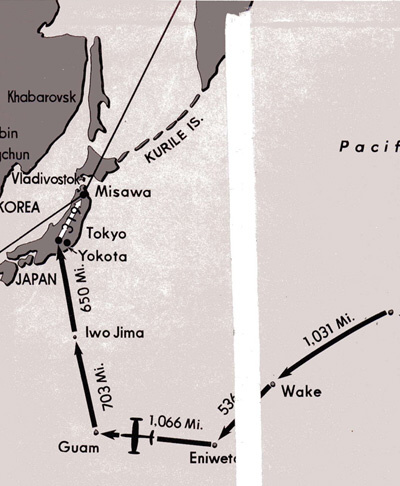 |
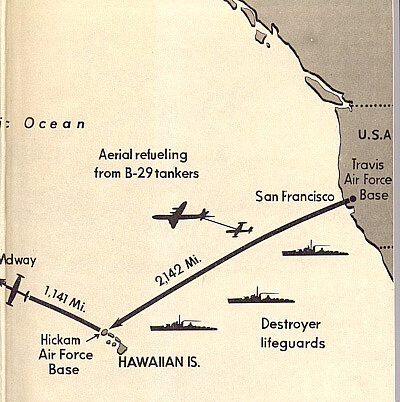
|
Map of Fox Peter One Flight - TAFB to
Misawa, Japan
|
TAFB to Misawa, Japan
|
The next day we flew to our
base at Misawa in northern Japan. Overall, a very historic flight. Enroute we
carried mail envelopes and had them stamped at each post office. Each pilot
got several copies plus some that all the pilots had signed. I still have mine
but I will give them to my son Jay for future distribution to my children and
grand children.
Our base in Japan was
at Misawa on northern Honshu Island. We had quite a few amenities there but
still it wasn't like being stationed at home. One of the problems was the
snowfall in winter. It amounted to over 400 inches and it was a problem to
keep the runways clear for takeoffs and landings. Also while flying, there
were continuous snow showers that inhibited your making a visual landing. You
would wait till you saw a hole and dive through it and hope that the field was
clear. Sometimes it wasn't and that is why we called these openings
'Sucker Holes'.
We had time off now and
then to go to Tokyo or to other small towns in the area. In the winter the
local town had so much snow packed on the roads that you had to walk down snow
steps of 4 to 8 feet to get to the stores entrance on the sidewalk. One of our
retreats was at a small town on a lake and was named Osamuchie. They had a
small hotel, good food and beautiful scenery and it was good to get away from
the base now and then. While at Misawa, I compiled and edited a book called
Fox Peter One [ the code name for our flight over the Pacific. I went to Tokyo
for a few days and had it printed. It was dedicated to one of our squadron
commanders, Lt Col Elmer DA Rosa, who was killed in an aircraft accident on
Iwo Jima on the way over. A copy reposes in my library.
Parties at the club were the way of
life. Women were the only thing missing. One of the games that was played was
called 7,11,21. It went something like this. You rolled dice from a cup. You
counted only the aces. Whoever rolled the 7th ace named a drink [probably one
that had several kinds of liquor in it] the one who rolled the 11th ace had to
drink the drink before anybody rolled the 21st ace. If you were the roller of
the 11th ace twice, that would be it. You had to leave the club with your
hands balled into a fist so that nobody would step on your fingers.
We had a haircut every day at the
Base Exchange. They cost only a nickel and the Japanese girl barbers would
give you a back and neck massage with each haircut.
One of our squadrons was stationed
on the island of Hokkaido at a place called Chitose. One day about 40 pilots
flew up there in our F-84s for a party and it was a good one. About midnight
our Wing Commander said 'OK, everybody into your planes, we're going back
to Misawa' and we did. Some threw up in their masks but we all made it back
safely?? Such was flying in the old days.
After our arrival at Misawa, one of
the pilots composed a song that went something like this; [I don't know the
name of the original tune but here we go.
We're sitting at Turner and hoping to stay at home
with our wives for awhile
But the wheels up at Offutt planned all summer long and told us to
wipe off that smile
They said go home boys and pack up your bags and do it as fast as
you can
Your going to Misawa but that's not so bad, its the best little
base in Japan.
{Refrain} It's a lie, it's a lie, its a lie, you know dam well
it's a lie, so pardon us please if we don't seem pleased, it's
a lie' it's a lie' its a lie.
We flew the Pacific in old Thunderjets from Hickam to Midway and
Guam
I'm telling you buddy a guy really sweats while flying that
Allison bomb [engine]
The General Met us as we taxied in 'Said men that's a mighty
fine show,
your headed for combat he said with a grin and I know your all eager
to go'
Refrain
We went to Misawa that stateside resort and really enjoyed our short
stay
with Geishas and Saki and all kinds of sport and it didn't snow
one single day
Our three months are up now and we're going home , back to the
place we adore
but now that its over why we all agree, we'd like to sign up for
three more.
Refrain.
And we didn't stay just three months, one trip lasted nine months
plus several three months trips to England. All in all it got pretty
tiresome for the families not to have a man at home. |
On some of the long range
deployments, I didn't make it without a serious problem. Probably the most
harrowing was in a T-33 that I was flying to England. Capt. Virgil I Sansing
and I flew two T-33s in formation. We were equipped with extra large wingtip
tanks.[450 gallons versus the normal 250 gallons.] The tanks were fitted with
a very long bolt that held the added sections tight so there would be no loss
of pressurization in the tank which would, of course, result in you not
getting fuel to feed from that tank. Somewhere over the North Atlantic ocean,
my tip tanks refused to feed.
I had some fuel in my center tank
but that was going down fast. I had to make the decision as to whether to bail
out over the icy terrain and get dragged to death by the wind blowing me in my
chute as I hit the ground or belly land it on the icy rugged terrain and die
in the crash. We headed on down to minimum altitude so I could find a level
spot to land or bail out. I jettisoned my canopy so that it would be out of
the way when I left the aircraft.
The antennae for the
direction finding radio was in the canopy so now I had no way to find our
planned destination base, Bluie West one in Greenland. Sansing stuck with me.
My main tank read 20 gallons and the engine was due to quit very soon. All
this time I was veering to the left and Sansing would get on my left wing and
force me to the right. His direction finder was working and he was trying to
get me closer to the base so rescue would be easier. This was in the winter
and we had been flying in ice fog that restricted our visibility. As we came
out of the clouds at a very low level, I could see how rugged the terrain
really was.
Miracle of miracles, the main tank
started to fill from the tips that were now feeding. At the lower altitude the
air was much denser and this allowed the tank to repressurize and feed fuel to
the main tank. Sansing kept me on the right heading. When I spotted the runway
below me, I pitched up for a circle to land and dropped my tiptanks because
one was empty and one was full and with the heavy weight on one wing I was
sure to cartwheel as I slowed down on the runway.
Everything looked and felt great
until I tried to pull the stick back to flare over the runway. It was frozen
tight and I couldn't move it. I just couldn't believe that after all that
I had just been through, that I was going to crash on final approach. I pushed
the flap lever to the down position and as the flaps came down, this gave me
the added lift to raise the nose and I made a perfect landing, came to a stop
at the end and all the base was out there to greet me. They had been following
my exploit on the radio.
I kissed the ground and then the
crew chief asked if he could have the plane to take it into the hanger to put
it back in flying shape. I said that the engine, etc. was OK but that I needed
some new wing tanks and canopy. He started the engine and started to taxi. He
went about 100 feet and the engine quit due to fuel starvation. The reason for
the elevator controls freezing was that I had my luggage in the back seat and
when I jettisoned the canopy, the wind force pushed the luggage against the
stick and in effect 'freezing' it. CLOSE..!!!
![Virgil I. Sansing [my saviour] and I when we flew a Japanese KATE](flying10s.jpg) |
| Virgil I. Sansing [my saviour] and I when we flew a
Japanese KATE |
Prior to the central Atlantic
crossing, [Cocoa Alpha flights] I had two navigators assigned to me. At that
time I was the Program Manager in charge of the USAF program to test celestial
navigation for jet fighters. We would pre compute what our sextant shots
should be on our route, make good a takeoff time and then when I took a shot
of the sun or moon, during daylight hours, I could determine by my numbers
whether I was right or left of course or faster or slower than planned.
This system worked great when you had lots of time to plan a flight.
I had proven the theory by taking
off from Turner AFB in a F-84, going under the hood immediately and flying
instruments all the way. At a preset time, I took my sextant shots, made a
determination as to my position, made a 90 degree right turn and let down. At
5000 feet, I took the hood off and Bergstrom AFB in Texas was right in front
of me.
The final test was on a flight from
Albany Ga. to the Azores. Code named COCOA ALFA. [CENTRAL ATLANTIC] I
pre-planned the flight for about 60 fighters, sent my two navigators to
Bermuda with our complete itinerary including guaranteed take off times
from Georgia and Bermuda. Off we go, from Turner AFB, right on time. When we
arrived in Bermuda for a fuel stop and a guaranteed take off time, I expected
my two navigators to have all my pre-computations ready to hand to me so I
could use Celestial on the very long over water leg to the Azores. They
met my airplane OK and the first thing that they said was 'When are you
going to take off?' I almost hit them. There was now no time for the
computations so I navigated that leg by time and winds and distance.
Very dangerous for 60 airplanes. Off we flew, on time but with no celestial
notes.
I briefed the group on how long it
would take and when we would see our first islands, etc. This was based on
flying correct indicated air speeds, at briefed altitudes and forecast winds
at altitude [Who knew the wind speed at 35000 feet over the ocean in those
days]?. Dauntless and unafraid, we headed East over the water cause 'Hank'
said we could make it with plenty of fuel to spare!
Fighter pilots do a lot of
chattering on a long flight of this kind. But as the time for landfall of our
first island drew near and nothing but water as far as you could see, things
got a little quiet as each wondered if I knew what the hell I was talking
about when I briefed them prior to takeoff and would we all be swimming
Eastward soon?
I too was a little apprehensive
because to tell the truth, I had no idea where we were. I figured that the
wind forecast was way off so I got on the radio and said' This is Hank, That
lousy dumb weather man didn't know what he was talking about and we will see
some islands in about 15 minutes. A wild ass guess on my part. That
seemed to satisfy them and the chatter started again. But in 15 minutes there
were no islands, I waited a couple minutes and said 'I can see them in the
distance at about 2 o'clock' {I really couldn't} but they had to be near
and luckily in about 6 or 7 more minutes, there they were and we all made it
safely into the Azores.
On one of the North Atlantic
flights of 20 F-84s,[Operation Longstride] we had planned to leave Albany
Georgia just before dawn, get in formation, refuel over Maine and again over
Greenland and Iceland and on into England. Well the refueling locks on my
airplane that grip onto the refueling probe from the tanker broke and I
couldn't refuel, so I landed in Greenland. Got out of the airplane and told
the ground crew to refuel it. Went into Operations and signed a clearance to
Iceland. The base said that I couldn't fly the North Atlantic alone. I had
my own clearing authority since I was a Command Pilot, signed my clearance,
got in my F84 and took off. I cut it short and flew over the ice cap and when
my tanks were empty, I dropped them so that I could catch up to the rest of
the airplanes. I tried to refuel over Iceland but I couldn't get any fuel so
I landed in Keflavik, Iceland.
Strategic Air Command [SAC} had
stationed control teams at all the bases enroute to help in case somebody had
to abort, like me. But they were up in the barracks when I landed in Greenland
and I had left before they knew that I had been there. They called SAC and
said that I was 'On my way'. They also said that when the tower told me
that I couldn't take off, I said 'Kiss my ass, I'm going anyway' Now
you know that I would never say that to a control tower. General Le May heard
about it and uttered his famous statement. 'STOP THAT MAN' Too late, I was
on my way to England.
When the main group of
planes landed in England, they were escorted to the Officers club for some
food and drinks. A few minutes later I startled everybody by walking in on the
party. Even with my stops, I had almost beat them to England. At that time, I
was the only pilot to fly the North Atlantic in a single engine jet fighter
ALONE. The 31st Fighter Wing ,also stationed at Turner AFB took off with 8 F
84s and flew the central Atlantic route and after a stop in Morocco, they too
flew into England. The code name for this deployment was LONGSTRIDE.
On the return trip we all
landed at Goose Bay Labrador and then at Bluie West One to refuel and spend
the night. The next morning I checked the weather and briefed all the pilots
on our route to Maine and also the runway length needed for the takeoff roll
for our very heavily loaded aircraft. {We had four external fuel tanks on each
plane} It was a short runway that ended up in a fjord.
I was in the first flight and we
went about 100 feet down the runway to allow the second four to also get on
the runway. Part way through our takeoff roll I realized that we were in a lot
of trouble because we were not going as fast as we should have been. I decided
to give my wingman 50 feet and yank the plane into the air. This worked but it
kind of scared us. The next flights had a warmer runway temperature due to our
jet exhaust which meant a longer take off roll. At the end of the runway was
about two feet of rocks and then a ten foot drop to the water in the fjord. We
used a small tug boat to push the icebergs out of our path. To make this
short, we all survived, most all planes hit the rocks and bounced into the air
and several touched the water with their belly tanks. . WHAT CAUSED ALL THIS?
ME ? The weather officer told me that we had a 15 knot wind but didn't say
it was a tail wind on the runway. so this meant a 30 knot difference in
the planned takeoff roll.
Also, just as we taxied out, our
weather officer jumped up on the wing commanders plane and said -It's zero
zero at Dow AFB Me., our destination, but no sweat.' Great news so I began
to figure out the course to our alternate base at Mc Guire AFB in N.J. Sure
enough, it was clear all the way but fog covered the spot where we were going
to land so on we all went to N.J. When we arrived there , the wing commander
put all 65 planes in close formation for our penetration through the clouds.
But there was a thunderstorm in those clouds and we ended up with
airplanes all over the sky It is impossible for 65 jet fighters to stay in
formation in a thunderstorm. We couldn't even see the plane in front of us
that one would follow down. We all lived through that one too and after
refueling, went to our home base in Albany, GA..
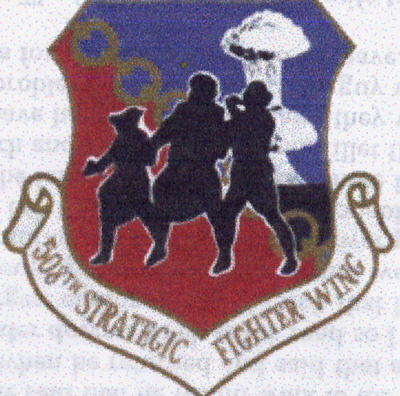 |
| 508th Strategic Fighter Wing Insignia |
I have to tell you
about a formation that we flew and called a 'WINGDING'. We flew this
formation while I was assigned to the 508th Strategic Fighter Wing and we were
deployed to Misawa Air Base in Northern Japan. It is hard to describe and
harder to fly but is a great show when seen from the ground, scary too.
First you get all your
airplanes in the air. We usually had about 65 F 84s. Then you put them all in
echelon. The only instructions that the pilots receive is 'FOLLOW THE PLANE
IN FRONT OF YOU'. So, the leader peels off and dives for the runway and
flies the length of it at couple hundred feet. All the planes follow at the
same altitude. Then he makes a climbing turn and dives for the runway at 90
degrees to the first level of planes, and passes under them. Next he makes
another climbing turn and dives through the loop in the train of planes. Of
course, some of them haven't completed the first pass. So you have airplanes
crossing the runway at three levels at very high speeds. He will pull up and
make another pass or two at the runway so that sometimes you have 65 jets in
five levels and all screaming by and missing each other vertically by about
100 feet. Scares me and I'm basically fearless. Those days are gone
forever because no commander in his right mind would attempt something like
that today. He would be fired right then and there.
Another interesting maneuver
that we pulled and this also happened at Misawa AFB in Japan, could probably
be called 'Screw the Army Anti-aircraft 5th Cavalry Division.' Our
commander, Col. Cy Wilson visited the large Army base in Hokkaido Japan and
during a conversation with the Army General, who commanded the 5th Cavalry
division, the General stated that, with his anti-aircraft guns, he could shoot
down every plane that attacked his troops. We of course said that we would put
65 airplanes over his guns and he couldn't shoot down even one bomb carrying
plane. The bet was made, seems they had to provide the food and booze if they
couldn't shoot down one plane. So I got the job of devising the tactics.
Their guns were radar controlled
and the secret that we knew was that the guns radar had to 'lock on' the
target for 20 seconds before it could fire. So here we come with 65 planes. We
had them in flights of three or four and continuously crossing back and forth
in the formation so that as soon as a gun locked on one, another plane would
cross in front and the gun would pick up that one and break lock on the first
target. They had cameras in their gun barrels to record any hits. We flew back
and forth over them for about 15 minutes and they never did score a hit, SO,
the party was on the Army.
That same General wanted a jet
plane ride to Tokyo and I was chosen to take him there. We had a new T33 and I
test hopped it that morning. It was in great shape. They also assigned a new
crew chief to this plane, his first. We got the General in the plane but I had
trouble talking to him on the intercom. We'll go anyway. As I taxied out,
the crew chief didn't give me the hand signals to put the flaps down and to
put the speed brake in. But the responsibility is mine since I was the pilot.
Even the Mobile Control officer, a good friend of mine, didn't check my
plane since he told me later that he did not know that we had a T-33. So I
gave it full power and we start to roll. Normally, I can lift it off in a few
thousand feet. When I reached that point I raised the nose and pulled up the
gear. But she didn't fly, It settled back on the runway. I decided to cut
the power and as it slid to a stop, I would walk out on the wing and jump out
of a sure fire. Then I realized that I had a fat General in the back seat.
The tail pipe was dragging and I
was on the extended speed brake that was getting shorter by the second. I
pushed forward on the stick to get the tail off the runway and hoped that I
could get enough speed to get airborne. Luckily, I had ten thousand feet of
runway. Hundreds of people were watching this and expected me to crash off the
end. But at the 9000 foot mark, I was able to get it in the air.
WHEW!!!. Colonel Schilling scrambled an F84 to take a look at what damage I
had and determined that the gear was O K but the tailpipe was flattened.
I flew around for awhile to burn off some fuel and landed back at our base,
OK. They had a DC 3 ready and put the General in it and took him to Tokyo.
Talk about a bad day. I was shipped
to the squadron at Chitose and my promotion to Major was pulled. Every day
can't be perfect. Every year when the promotions came out, I was the leader
of the 'Sick Captains Club.' It took four more years for me to put on my
Majors leaves. This in effect denied me future promotions, denial of senior
schools and I retired as a Lt. Col. rather than possibly a Colonel or
Brigadier General.
During this period, at Turner AFB
in Georgia, Robert S. Johnson, who was a Tech Rep for Republic Aviation and
also a 28 victory ace from WW II, came to Turner AFB to make a movie or
training film of the F-84. I was the Air Force technical and tactical advisor.
Bob was one of our ranking aces and he and I hit it off perfectly. I felt kind
of honored to be his friend. Years later we were in South Carolina and went to
dinner at his house. Millie and I both agree that we have never been hosted in
a more royal manner.
During one of our trips to England,
we were stationed at Manston RAF station on the southern tip of England. One
of the officers that was permanently stationed there had his car sent
over. It was a new Lincoln. We all went for a ride in it. I was in the front
passenger seat. About one mile down the country road the driver said 'We
just made 70 miles per hour'. The next thing that I remember was waking up
in the dark, nobody else moved in the car. I got out and ran in the mud to
what I thought was another car coming, except that I was running in the wrong
direction, ran into a barbed wire fence that spun me 180 degrees and then I
was able to get to the road and stop a car. It seems that at 70 MPH he hit a
telephone pole head on. The car was ruined and the other passengers finally
awakened and were all OK. I had a clavicular [shoulder] separation and
couldn't fly for a few months.
Also in England some friends gave
me an Irish Setter that was named Beecher. I kept him in my room at the
Officers Mess, where we were billeted. One day I noticed a message on the
bulletin board that read 'An American officer is religiously disobeying the
rules of the Mess by keeping a Red Setter in his room'.
Beecher was fun to have and also a
large problem. He would go to operations with us and seemed to like the Wing
Commander, Col Dunham and always put his paws on the colonels chest, muddy and
wet. To confine him I tied him to an aerial target about 60 feet long. Even
this did not deter him.
One day a local farmer came onto
the base with a Bobby and was looking for the owner of a red setter. I owned
up to being the owner and was told that my dog had gotten into the farmers
chicken coop and had killed 60 prize pullets. I went with them to the farm to
see the damage. Sure enough, there were 60 chickens that had been scared to
death. Luckily, the farmers dog had also been in there so I was only
responsible for half of the damage. I paid the farmer and then demanded 'My
Chickens'. They gave them to me and I took them to the Officers Mess and
sold them to the mess and I think that I made about ten Pounds Sterling.
Beecher's stories aren't over
yet. It came time to rotate back to the USA. I left a few days early and one
of my friends put Beecher on a B-17. When it landed in the Azores, it lost an
engine and was delayed a week or so. When Beecher did arrive at Turner AFB
there was a large crowd to greet him. Signs had been made out of rolls of
brown paper which said 'Welcome Beecher' 'Change your pounds for dollars
here' and several others.
We took Beecher to our home but two
days later he disappeared. Hunting season was on and I guess he was stolen for
a bird dog to hunt quail, the only problem with that was that Beecher was gun
shy and would run away if you fired a shot near him.
Col. Cy Wilson was my wing
commander in the 508th Strategic Fighter Wing. We were scheduled to receive
the new swept wing F-84F and one did arrive about 22 Dec. Col Wilson decided
to take it to Bergstrom AFB in Texas for Christmas, as his home was close by.
On Dec. 28, we needed a part for
one of our planes and someone had to fly to Mobile Ala. in very bad weather to
pick it up. I volunteered since I love to fly in instrument weather. I picked
up the part and was filing my instrument clearance when the Sergeant in
operations mentioned that there had been an F-84 crash at Pineola Miss. I said
'That's my Wing Commander Cy Wilson' The sergeant said that they did not
have any particulars as to what model aircraft it was. How did I know?????. I
took off and flew back to Turner AFB and upon landing I was met by Colonel
Johnson and several other senior officers. Their first words were 'What
happened to Cy?' They thought that I knew all about it. Very
strange.!!!.
Later we found out that
it was Col. Cy. It seems that he was at altitude and started to have engine
problems as he was going through some clouds. Since there had been a rash of
engine problems in the F-84F, he decided to try to bring the airplane down in
one piece so we could find out what was causing the problems.
Well it was a drizzly rain at lower
levels, almost dark and he still stuck with the plane. He saw an open field,
the engine was dead by now and he had very limited control of the plane, [The
elevator control at this point is by electric and is toggled by a trim switch
on the stick. The response is very slow and control is marginal]. The
'book' says to bail out since at that time I don't think there were any
successful landings using this system, and he tried to land. Did a great job.
We could trace his flight path through a wire fence, across a road and a
smooth touchdown in a field, but at the last moment, a wing dug in and the
plane cart wheeled into a tree and a branch came through the canopy and
hit his helmet. A highway patrol officer happened to see the crash and got Cy
out of the plane but he died from his wounds in a few minutes.
It wasn't all in vain. We did
find the engine and the cause of the accident was compressor blade seizures.
What happened was that as he passed through super cooled moisture at altitude,
the compressor shroud would shrink. This would slow the compressor and the
fuel control would sense this and put more fuel to the burners. This extra
fuel made the blades hot and they would expand and scrape the shroud , etc,,
etc,. Finally the slowed down compressor would have excess fuel and at a slow
rate of speed, would blow up the engine. We found this problem and were able
to fix all the other airplanes. I was honored to be one of his pallbearers
when he was buried in a very small cemetery in West Point Texas.
The story doesn't end here.
Millie and I were very close friends of Cy and his wife, Charlene. We were
transferred to another base, Charlene and the kids left Albany GA. and were
not heard of for many years. Many people look to me to tell them the
whereabouts of mutual friends. I keep up with many of them. On a trip through
Texas I stopped to visit and old acquaintance, Capt. Tom Hunter. While having
a drink on a rainy afternoon, he mentioned that Cy Wilson was buried nearby. I
immediately said lets go find it. He didn't want to go in the rain and
really did not know where the cemetery was. I persisted and we headed out. We
stopped at a small country store and asked the lady that owned the store the
directions to the cemetery. She said 'Go down this dirt road and take the
first road that you can to the right, it is back in there.'
We went down the road and the first
road seemed to lead into a farmers house so I told Tom to keep on going. It
was getting dark and the weather was miserable. We went through a small swamp
and as we came out the other side, there were several old graying buildings
and a car was parked in front of one of them marked 'Post Office'. I told
Tom to drive over there because those people might be having a problem. He did
and as we pulled next to the vehicle, I was next to their passenger side, an
elderly lady rolled the window down. I noticed that there were two women in
the car.
I said 'May we help you in
anyway' She replied that they were OK and asked if they could help us? I
said that we were looking for a cemetery. She said 'Who are you looking
for?'. I said' Col Cy Wilson'. The drivers side door opened and the
driver stood up and said 'I'm Mrs. Wilson.'
After all these years, this was
unbelievable to me. They took us to the grave sight and the next day I drove
to La Grange Texas where they were living and Charlene and I had a drink or
two and dinner. She had been living there for years taking care of her Mother.
The Mother had been the postmistress at that old post office and they had
driven over to see the building. That was the first time in many years that
they had gone to that area. Coincidence ???. Amazing, I still get goose bumps
when I tell the story and picture Charlene getting out of the car and saying
'I'm Mrs. Wilson.'
We had quite a few TDY trips to
England and Japan. Each one lasted from 3 to 9 months. We bought our first
house in Albany Ga. and it wasn't long after that, that I was selected to go
on a secret project for USAF. Probably the best thing that ever happened to me
because it changed my whole life and even today it has a great influence on
it. I'm talking about the U-2 project.
In mid 1955 a colonel from Hdq. SAC
came to Turner AFB. He was recruiting pilots for a very secret project. He
also was looking for a fighter pilot with experimental test time and lots of
fighter jet time. He took me and Lt. Setter an aeronautical engineer who
worked in my office of Wing Plans. We were told nothing of what we were going
to do or any other details.
I was told to report to March AFB
in Riverside, Ca. Upon arrival I met the other personnel who were to make up
this group. Col. Wm. R. Yancey was the commander, Col. Herb Shingler was
deputy and also Chief of Logistics, Col. Phil O Robertson was the Operations
chief, Maj. Jack E Delap was chief of navigation and Major Garvin {a B47
pilot} was one of the experimental test pilots along with Capt. Louis Setter
and myself. There were several other officers assigned for various duties and
a few airmen.
We were also told that
the project was TOP SECRET and nobody was to know where we were or what we
did. PERIOD. At this time Mildred and the kids were still in Albany Ga. I
bought a house at 4505 Gay Way in Riverside and a few months later I flew back
and drove them to Riverside Ca.
After meeting all the other
personnel and noting what high caliber they were, each of us later
agreed that we wondered how we had been picked for so important a program. We
received our briefing of a general nature and those of us that were to be
involved with flying were flown to our operating base in the Nevada desert.
{Later to become infamous as AREA 51 } The program was one of a high flying
reconnaissance aircraft that had not even been tested yet.
Note: On Nov. 19 th 1990, there was
a special on T V that chronicled a release by CIA of the 45 year secret
surrounding the crash of a C-54 airplane on Mt. Charleston, close to Las Vegas
NV. This was the courier plane from Burbank Ca. to area 51, our then secret
base. We heard of the crash and sent all our airplanes on the search mission.
I happened to be the one that discovered the crash site, very close to the
crest of Mt Charleston. The airplane burned and 14 people were killed. The T V
release was in complete error on many items, the most major one was that it
was a chartered airplane when in reality it was an Air Force C-54. I know, the
same airplane had taken me up to Area 51 about ten days before the crash, and
this was our daily courier airplane. Note: This release was the start of the
National Cold War Memorial and Monument in Las Vegas of which I was The
Honorary Chairman.
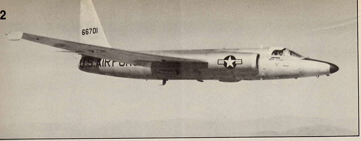 |
U2C with Air Force Markings
|
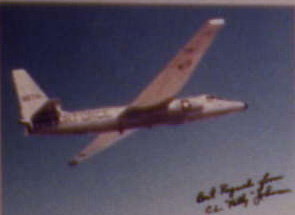 |
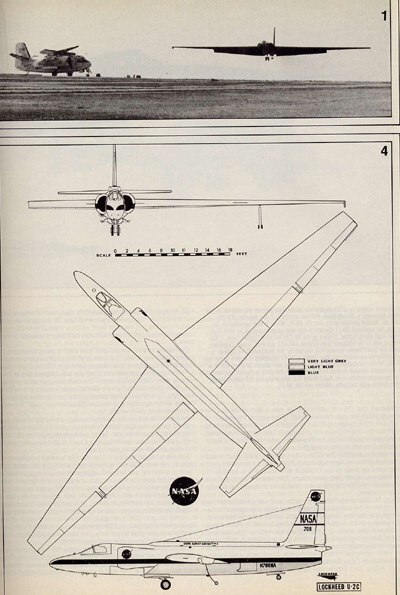 |
U2A design flat plan - Area 51
|
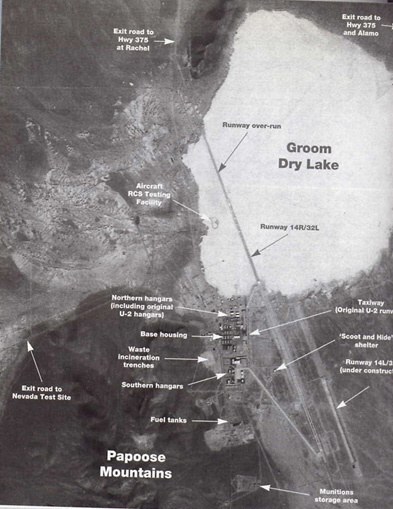 |
Area 51
|
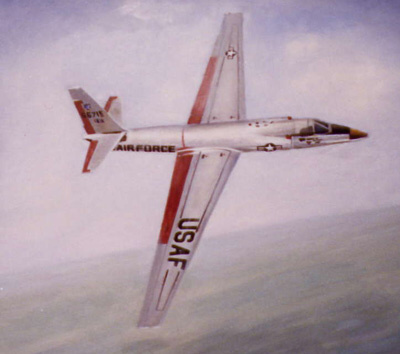 |
U2C with Air Force Markings
|
During this period, the
Lockheed Engineers led by Ernie Joiner and his experts [when you consider the
job that these brilliant men did in the timeframe they had, EXPERT does not
fully explain the results of their expertise and dedication] were at the area
and the LAC test pilots were testing the plane. The pilots were Ray Goudy, Bob
Seiker, and Bob Schumacher. I'm correct in stating that these three did all
the phase testing and Tony Levier only flew two low altitude flights. We three
flew the same and sometimes more advanced missions as the LAC pilots. Time was
a deciding factor and anything that we could add to the test phase was
accepted.
Of course, we had to
experience the flight profile before we could tell a student how to fly, and
more important, decide the better way to accomplish the mission.
There were 2
airplanes at our test site and I think that they had been flown at low level
for probably no more the 5 or 6 hours. Robby, Garvin Setter and I were
checked out for low level flying and then went to David Clark company back in
New England to be fitted for partial pressure suits. This company
also made braziers and we were given a few samples to take back home. Hard to
explain to the women and harder to determine the size. I think that we
all decided what size we needed.
[The sizes that we
returned with ranged from melons to fried eggs]. Note: I kept my complete
partial pressure suit and a few years back I took it to Wright Patterson Air
Force Base and donated it to the USAF air museum. They plan to use it when
they set up a diorama with their U-2 and 'another' dummy will be wearing
my suit. This should occur in Sept.2003.
The pilots were
starting to arrive, six in the first group and we only had a few hours in the
plane ourselves. We gave them ground school on the aircraft systems, emergency
procedures, flight planning, navigation, etc. etc. flying this airplane.
Prior to our giving the ground
school, we had to devise the procedures that were to be used in the air and in
preparation for a flight. This included preparing the route, fuel consumption,
checkpoints, pre-breathing for 2 hours and all the myriad details necessary
for an overflight of normally denied territory. Remember, this was a new type
of aircraft flying in an environment where nobody had flown before. To get
these pilots ready to fly the U-2, we had to be very certain that they were
excellent pilots, as the U 2 was the first million dollar airplane. To do this
we would put them in the back seat of a two place T-33 jet and take them
for rides.
Landing the
U-2 was very difficult and it had to be flown within 2 MPH to make a safe
landing. Knowing the exact stalling speed of the T-33, we
would have the pilots fly at 2 knots above the stall speed, 2 feet above the
surface of the dry lake. We would induce contact with the lake to let them
develop the correct recovery procedures. When we were completely
satisfied that they were not only accomplished pilots, but were capable of
transitioning to this new airplane, we would then check them out in the
U-2.[There were no washouts as all the pilots were well qualified and all did
an excellent job].
At the end of each T-33
flight I would regain control of the airplane, climb to 10,000 feet, put the
gear, flaps and speed brakes out and then shut the engine off. On the lake we
had several painted cross marks and my aim was to land as close as possible to
this mark. After a few practice flights I was able to consistently touch down
within 100 feet of the mark.
We had a
souped up Mercury station wagon that we used for mobile control and to chase
the plane on takeoff and landing. On landing we would race alongside and to
the rear of the plane and call out his altitude above the
ground,' two feet, two feet, one foot, one foot, O.K. ease her on down.'
They still use this system today, 48 years after we devised it. {The vehicle
that they use today at Beale AFB in Ca. is a souped up Thunderbird, and I and
Millie got to ride in this chase car for a few landings. Scared me as the
driver hit 120 mph around the taxi way and onto the runway]
A rare photo of some of my U-2 students flying in a Diamond
Formation
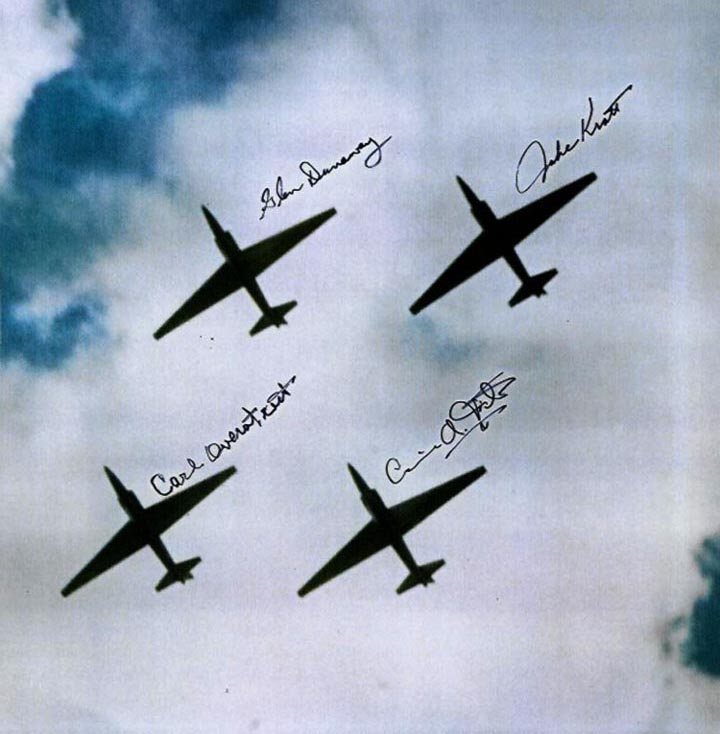
This photograph, made in Europe in 1957, shows aircraft of the first U-2
detachment to be deployed for operational use in intelligence gathering. On
this particular day four aircraft were flown on shakedown flights, with
take-off and landing times that resulted in their being airborne at the same
time. The pilots, experienced fighter pilots, took this opportunity to
exhibit the U-2 to ground personnel in a fighter show formation - the
Diamond.
Lead aircraft, Glendon (Glen) Dunaway; right wing, Jacob (Jake) Kratt; left
wing, Carl Overstreet; slot, Carmine Vito. This undoubtedly is the first - -
and only - - four aircraft formation flown in U-2 airplanes.
Photo taken by Hervey Stockman
There was a plan to
put the Air Force U2 squadron [sometime in the future] at Turner Air Force
Base. I went back to advise on the placement of the GCA [ground approach
control vans] on the base.
There I ran into a
problem with the Division Commander who wasn't used to taking
suggestions from a lowly Captain but I was SAVED by my good friend Col.
Gerald Johnson.
Training and flight
testing progressed on schedule and it wasn't too long that our first
detachment was deployed to the UK. All was not perfect, as expected with
an experimental aircraft that was extending the state of the art in high
altitude flying, We lost a few pilots and airplanes.
To support our
efforts we had one C 47, 3 or 4 T-33s, one B-25, a twin Bonanza and two
Navions. Robbie and I went to Sacramento Air Depot to pick up the two
Navions. He received his right away and left for Riverside Ca. I had to
wait awhile for mine and the Chief of the depot, a civilian , told me that
the plane that I was picking up was supposed to go to General Le May. He
asked who I was and where I got my authority? Of course I couldn't tell
him . I just said ' That's the way it is wherever I go'. Signed my
own clearance and took off. [Note: In those days the wing and base
commander personally had to sign all flight clearances, except the pilots
in our unit,]
There were some
developmental and technical problems but I can only discuss these as they
relate to the operational use. The first was the way to land this
aircraft. You may remember that on the high speed taxi tests, the plane
became airborne and they had great difficulty getting it back on the
ground. On the first test flight, the pilot tried several times to land it
on the nose wheel but luckily was able to stall it and land although the
firm application of brakes resulted in a fire at the front tire. This
caused no damage to the aircraft.
An oil film would
appear on the windscreen and clouded the forward visibility and increased
the landing problem. Mr. Johnson solved the problem but during the
interval we used a sanitary napkin on the end of a stick to clean a part
of the windscreen so that we could see out to land. FUN.
Flameouts at altitude proved to
be a significant problem since the cockpit would depressurize, the suit
would inflate, you couldn't talk on the radio since oxygen was being
forced into your faceplate and mouth at a great rate and the aircraft was
descending, slowly. Also the neckpiece of the helmet would pop out and you
had to hold it in as far as possible with one hand and fly with one hand
and all in a very dangerous predicament, to say the least. It didn't
take Mr Johnson and the Pratt and Whitney engineers to solve the flameout
problem [a bleed valve succeeded to eliminate a lot of the flameouts] and
from there on out it was a lot less hazardous to fly at altitude.
The Russians had satellites by
this time and one would periodically fly over our base. To keep our work
secure, we hangered the aircraft whenever one was due to overfly us.
On one of my U-2
flights, I flew up to Alaska to check out the high altitude, high latitude
wind patterns. I was able to keep the aircraft exactly on course, despite
the high cross winds by using the drift sight [a device that lets you look
directly under the plane and see what your course is and determine any
drift] I had a C 54 fly along under me in case I encountered any
difficulty.
On another flight I flew way
out over the Pacific ocean to also check the wind patterns but this time I
developed engine problems and the engine quit. The pressure suit blew up
and I descended to 30,000 feet to attempt an air start. It worked and I
climbed back up but it blew out again. Down I came. This happened about 15
times until I was able to return to our base. FUN?
To solve the
problem of not being able to communicate when the engine flamed out and
your suit 'blew up', I went back to the David Clark Co. and they built
a new suit for me that had a chest bladder installed so that when the suit
was pressurized, pressure on your chest would allow you to talk. I took
this to Wright Patterson AFB where there was an altitude chamber.
I donned the suit, entered the
chamber and they lowered the pressure until I was at a simulated altitude
of 120,000 feet and then broke the seal. The suit inflated and I started
to shout 'I can talk, I can talk, can you hear me?' They of course
could and that solved the inability to communicate during a flameout.
I don't remember
on what flight this happened, it could well have been on the one that I
just told you about since I was very concerned at times [It was a long
swim back to Calif.] and with the suit blowing up about 15 times, it is
very possible that this was the cause of my hyperventilated condition. As
I came in for a landing my mobile control officer was Lou Garvin. As you
may know by now, his job was to assist the pilot to land by calling out
his altitude above the runway as he raced alongside in a souped up
Thunderbird. The one thing that you had to be very careful of was to not
hit the front gear first as that would make you bounce and porpoise and
being near the stall, there was a great possibility of breaking the
airplane. Well, in my hyperventilated condition, Lou was calling two feet,
two feet. one foot, so I said 'Screw you' [can't think of the actual
word that I used] and jammed the front gear onto the lake bed with the
nose about a foot off the ground and the tail high in the air. An
impossible maneuver but I left the power on and went two or three miles
that way before I pulled the power off and let it settle to the runway.
When the Docs met me they said that 'I was grounded until they could
evaluate my condition' and that set me off again. I gave them all hell
but in a little while the effects of too much oxygen wore off and I was
back to normal.
The First U2 to land at an off
base location landed at Albuquerque New Mexico. The base commander was
notified that it was coming in so as soon as it landed, they put it in a
hanger and covered it up with canvas. A few days later, after it was
repaired, Lou Setter and I flew down in a T-33 to pick it up. I was to fly
it back to Area 51. We started it up in the hanger, I taxied it to the
nearest runway, took off with only partial power, so as not to show the
capability of the plane, kept it very low to the ground. Off the end of
the runway was a deep ravine so I flew down there until I was a long
distance from the base and then climbed back to high altitude and made it
safely back to Area 51.
In the early days we had many
engine failures and flameout's. This happened to many of us. I think
that I made 2 or 3 dead stick landings. One of the Lockheed pilots did
just that and was rewarded with a 25,000 dollar bonus. At the end of the
program I was rewarded with a Distinguished Flying Cross. Such is
life.!!!. When we finished all our training and testing, we checked out a
few Air Force pilots and we all went on to overseas assignments. At the
time that we left I was 'High Time ' pilot with 121 hours in the U-2.
After being certified that I
actually did fly experimental test flights in the U2 and F84, I was
accepted by the SOCIETY OF EXPERIMENTAL TEST PILOTS as an associate
member. Truly a great honor.
Of course, not all
flights were perfect I chased several planes that crashed on the desert.
One in particular, the engine was still running and fuel was pouring out
of the broken wing and the pilot was unconscious. I jumped up on the wing
to pull him out. I was afraid to shut the engine off, for fear of causing
a spark and starting an explosion, so I dragged him out but the seat pack
was attached to him and the wire wrapping was holding me back. I had to go
back in the plane and release the seat pack and then continue to drag him
across the desert until the fire trucks and ambulance arrived.
On a night check
out for one of our pilots, he crashed into the base of the control tower.
I was right behind him and our Doctor was also there in his ambulance. We
both drove into the flames to rescue the pilot. The Doc saw him first and
hollered to me that he was dead so we left him there for the fire people
to pull the body out and we both took our vehicles out of the flames
Note: I am planning
another book on the Early Days Of Area 51, wherein I intend to tell the
true story of the happenings during that period. All my facts will be
garnered from the people that 'WERE THERE'. I can understand ones
memory fading, and mine has too, but some of the claims are downright
ridiculous. Should be a fun book to read. Now, if the buzzards will quit
circling until I have a chance to complete it, I might reveal an
interesting period.
While stationed in
Europe, just after the U-2 program,. General Powers, Commander of
Strategic Air Command presented me with the Distinguished Flying Cross for
my U2 test experiences. This included my saving several U-2s by making
engine out landings on the dry lake. [Note. When a Lockheed pilot did the
same thing, he was given a $25,000 bonus.
Later on I was accepted as an
associate member of the
SOCIETY OF EXPERIMENTAL TEST PILOTS,
a very exclusive flying organization.
INTER ACTION WITH VERY INTERESTING AND IMPORTANT PEOPLE
Around 1965 I was assigned again, to exchange duty at CIA headquarters, as
the Operational Officer for the YF-12A and follow on SR-71. During this
period at Area 51, I got to know Mr. C.L. Johnson, the designer of the
U-2.F104, T-33, etc. etc,. I would commute to the area or LAC Burbank
almost on a weekly basis. I attended many meetings with him and the other
contractors, Pratt and Whitney, David Clark Co, etc,. There was always
friendly banter between the CIA, LAC and the other contractors.
At
one particular meeting at Area 51, LAC was having great trouble getting
the YF12A supersonic. They had to dive it to attain that speed. Also Pratt
and Whitney, the engine manufacturer, had one engine that would overheat
on every test flight.
Finally the engine problem
was discovered, it seems that the rotor and stator blade discs could be
installed backwards and this had happened to one of the stator discs thereby
inhibiting the flow of air through the engine. Mr. Johnson had a great time
berating the P & W rep [I think it was a Mr. Brown] and chiding him for
the engine being put together backwards.
Mr. Brown took this very
calmly and when Mr. Johnson was finished, he stood up, apologized for the
error, which could happen and then addressing Mr. Johnson said 'Mr. Johnson
Sir, we note that you are having a problem making the YF-12A go supersonic. We
respectfully suggest, Sir, that you may solve your problem, if you were to
install the wings on backward'. That ended the meeting.
Once during a Blackbird Reunion in
Sparks Nevada, Mr. and Mrs Johnson wanted to go to Harrahs automobile museum.
Mildred and I were also going so we took them in our car. Mrs. Johnson was in
a wheelchair then and I got to push her all through the collection.
Mr. Johnson decided to retire from
LAC and they held a retirement party for him at the Sportsmen Restaurant in
Burbank. I was invited as the CIA representative. All the wheels in the
aviation industry were there. I happened to be standing near the stage when
Kelly said, lets have a 20 minute break. As he left the stage he spotted me
standing there and came directly to me. We stood there and made small talk for
the full 20 minutes. One could see the 'Lackeys' hanging close and
trying to speak with Kelly. To no avail. Finally he said that he had to get
back on the stage and would see me later. A very proud moment in my life for
this was truly a great man. His follow on Vice President, Mr. Ben Rich, [a
very distinguished aeronautical engineer in his own right, who developed the
Stealth F-117] was also a very good friend of mine. Both of these gentlemen
are now gone
In 1957, Millie and I were
transferred to the UK as were most of the other pilots from the U-2
group. While there I got to fly the C-47 to Europe and not much else. But even
flying the Gooney Bird can be fun. Working in the Command Post, I controlled
the flying hours. So when a request came in to fly Jane Mansfield and a group
of reporters to one of our bases for a football game, I okayed it but put my
self down as pilot.
The trip up was uneventful in good
weather and I got to go to the rear of the plane and talk with Jane for
awhile. I guess they all went to a party after the game and the weather
turned terrible. Rain, low ceilings and about 1/2 mile visibility. Right after
takeoff my copilot went to the rear to meet the people and I was left alone to
fly the plane. Not an easy job what with flying in rough instrument conditions
and
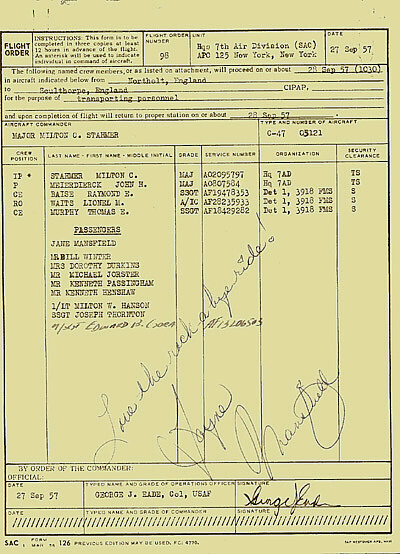 |
| Orders to fly Jane Mansfield |
working the radios, etc. A British female reporter came up front and sat in
the copilots seat. That was O K but then she began interrupting my
concentration by grabbing switches. I told her about three times not to touch
anything but when she did it again, I grabbed her someplace on her front area,
pulled her out of the seat with my right hand and hollered for the crew chief
to get her out of there. The destination was about 200 feet visibility and
about 300 foot ceiling but I penetrated OK and landed safely.
Miss Mansfield and her friend,
Mickey Haggerty, lived quite close to us in England. I was hosting a small
party for members of the old U2 group and invited the two of them for drinks
and dinner. They tentively accepted but the day before the planned event,
called and declined. It was close though.
I made several trips to Turkey and
other countries in Europe. In all my years the only time that I had to go to
my alternate base was on a trip to Germany. The whole area was socked in
solid, below minimums so I returned to England. I guess that the only time in
about six or more hours, that I saw the ground, was when I rolled down the
runway on takeoff and rolled down the same runway on landing.
One of my friends was a Lester
Robinson. A great maintenance officer but a scared and lousy pilot. I took him
on a flight to Israel in a T-33. When we arrived in Israel it was dark and I
made an approach to what I thought was my destination but it turned out to be
one of their top secret bases [Nuclear Depot?] well, they redirected me to
another base and things quieted down. I visited the U S Embassy and they were
kind enough to give me a car and driver for a tour of Israel, the Dead Sea,
etc,. All in all, a great experience. Even visited the tomb of the ASCUNCION
and the spot underground where JESUS had his carpenter shop.
Our Wing went to Manston RAF
station on deployment from Turner AFB with our F-84s so I did get to fly jets
in Europe but not in combat.
On one of our deployments to Japan,
Col. Schilling and I flew to a base in Korea and flew a couple missions over
North Korea. One day our whole wing loaded up with bombs and headed East but
when we got to Korea. the clouds were too thick to penetrate so we all dropped
the bombs through the undercast and I have no idea where they landed. I
finally did get a ribbon for the Korean war in 2002.
When our three years in England
were about over, everyone expected me to be sent to a bomb wing or
headquarters in the states. I had faith in a Fighter assignment and wagered
numerous bottles of booze on the outcome. I got a great assignment as Director
of Operations for the 414th Fighter group at Oxnard AFB Ca. an Air Defense
Base flying F-101B interceptors. Our primary mission was air defense of
Southern California. Vicky was quite small at this time and after watching an
ad on TV, she announced to all that she would sleep well that night because
the National Guard was on ALERT.
Before I could check out in the
F-101 I had to show my flying proficiency in a T-33. One of the Lts. took me
for a ride. Just after takeoff he pulled the throttle back and said
'Simulated Flameout'. Remember all the times at area 51 when I used to
practice dead stick landings. Well this was old hat for me so I calmly told
him that since it was calm and we were only about 500 feet in the air that I
would land downwind at the 500 foot mark on the runway. Which I did and took
off again. He did it again and this time I told him that since there was no
other traffic, I would land at exactly the same spot that I had a couple
minutes ago. And I did. Again I gave it the throttle and climbed on out. At
10,000 feet he tried me again. This time I said that I would land in the
correct direction and touch down at the 500 foot mark. Right on the nose. He
said that that was enough and I taxied to the ramp. He complimented me and
I'm sure there was a lot of talk the next few days about the Lt. Col. who
knew how to fly, with or without an engine.
I didn't fly the F-101B too
often, maybe 10 hours a month but finally I took a turn at sitting on ALERT.
Again they were going to test me and in the middle of the night they scrambled
me. I was directed to GATE' which meant full afterburners on and then was
directed to a target about 75 miles away. We found the target, SPLASHED IT
[which meant that we hit it with our simulated weapon] and returned to base in
less than 20 minutes. I was accepted by the younger pilots then since I had
passed their test.
In the nearby town of Ventura
Ca. a group of very rich businessmen had formed a club called R and R [ rest
and recreation, I think] They furnished a vacant store with some sparse
furniture, had a bar etc,. They would meet every Friday afternoon and invite
any officer from any of the USA services or any foreign friendly country to
visit with them and have a few drinks and small talk. This of course was free
to the military. Being a USAF Lt Col and Director of Operations for the 414th
Fighter Interceptor Group, I frequently attended these gatherings. They would
ring a bell and their leader would say things such as - Joe, I heard that you
shipped 10 carloads of lettuce this week, That will cost you $10,000. Or Jack,
I heard that you shipped 8 truckloads of strawberries. That will cost you
$5,000 or whatever came into his mind - The money all went to charity.
One evening when I was in
attendance, I noticed a portly gentleman in a suntan uniform with gold braid
all the way up his arm and all kinds of ribbons. Trying to make conversation
with what I thought was an officer of an allied nation I said - Sir , what
country do you represent.' He stared at me for an instant and said, -
"I am Rear Admiral Brown, Commander of the U. S. Navy Missile Command at
Pt. Mugu Ca." - After stuttering a few words, I excused myself before he
could determine who this stupid Air Force officer was.
YF-12A CHECKOUT
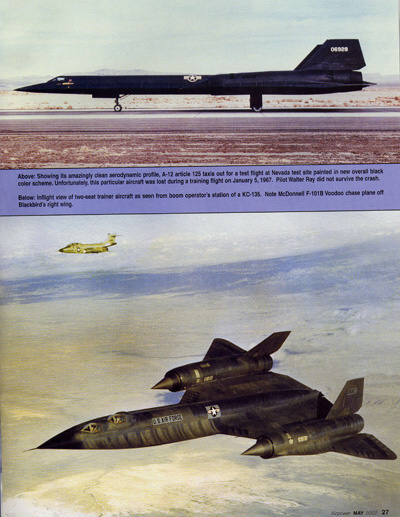 |
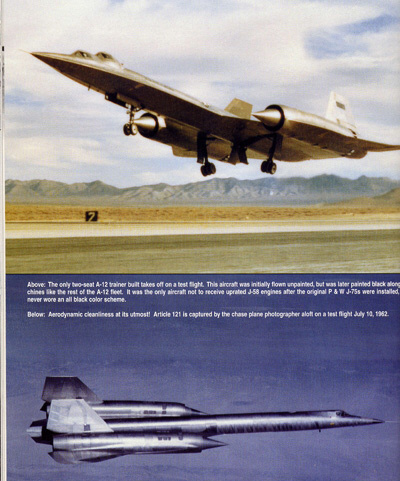 |
YF12A, forerunner of SR 71
|
YF-12 Taking off - YF12 top view
|
After finishing my
tour with interceptors, I was as signed to CIA Hdq, in Va. I was able to
fly the T-33 from Andrews AFB and when I visited area 51 as the Weenie
from Hdq., I got to fly chase of the SR-71 in a F-101, and instruments in
a C-130 that belonged to us. I also complained to my boss, Gen. Jack
Ledford that if I was to be Hdq operations boss for the plane, then I have
to fly it.
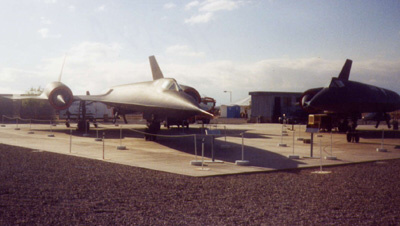 |
| YF12A at Blackbird Park |
The time available on the aircraft
was very critical but I went to a short school at Lockheed, then Ray Haupt, a
pilot that I had checked out in the U2 gave me the checkout. This occurred on
5 Dec.1963. We flew the dual YF-12A at low altitude and I shot five landings.
That is considered a checkout so I brought my ejection seat spurs' home
with me and they are behind my bar right now. During this flight, the whole
base contingent came out to see if I really could fly. They were surprised
when I made very smooth landings and we all had a few drinks that night.
I was asked if I would
like to return to Area 51 as the Commander of a new airplane project named
Aquiline. I of course jumped at the chance so we packed up the household goods
and headed West towing a horse trailer with Vickis pony in it. Another real
adventure. Maybe I'll make a separate chapter about that trip later on.
Project Aquiline was a
project to develop an RPV [Remotely Piloted Vehicle] The contractor was Mc
Donald Douglas. I had an admin staff headed by a CIA professional, Mr. Andy
Frisina and three pilots that were to be trained to fly this BIRD, and a
Maintenance Officer. A small but knowledgeable group. We were stationed at
area 51 and commuted about once a week, depending on the flying schedule.
The contractor had the
responsibility for the development and test and we were to assume command as
soon as I declared the vehicle 'Combat Ready' Things didn't start off
too good with the Contractor since they didn't want me or my people looking
over their shoulder. They tried to keep everything secret from me and they
were helped by some of the staff officers from headquarters who would operate
behind my back and try to leave me out of the picture.
Progress was very slow. The
vehicle was a six foot long plane that had a small pusher prop and actually
looked like an Eagle or Buzzard when it was in the air. It was designed to fly
at very low levels along communications lines and intercept their messages. It
also had a small television in the nose as an aid to navigation and to
photograph targets of opportunity. There were several successful flights and
some crashes [reason unknown] and some lousy landings.
This small vehicle was
launched from inclined rails and was recovered in a large net strung between
two poles. Progress was passable, but then came budget time. The contractor
predicts the amount of money needed since I did not have the intimate
knowledge of the development expenses. I had 11 million dollars for the
following year and I advised Macdonald of this fact and asked for the next
years operating budget.
They came back to me
with a 110 million forecast, Ridiculous!!. I returned to HDQ and discussed it
with the bosses and they suggested that I give them two weeks to adjust the
amount and then to come to DC with the result and have Macdonald Douglas
present their budget. I did just that.
They decided to back into the
110 Million number rather than actually justify the true amounts needed. A
grave error. I was forced to interrupt them many times during the presentation
to point out errors and outright lies. Upon the completion, I was asked for my
comments.
I explained that we really needed
only 11 Million and could not possibly spend the larger amount. I also pointed
out their exaggerations, padded costs for items and the brazen lies that they
tried to force on the group. My big boss asked me what I thought we ought to
do. I stated, in no uncertain terms that since this group tried to charge 110
Million for a 11 Million job, that I couldn't trust them and that 'WE
SHOULD CANCEL THE PROGRAM'. He said 'I think that you are correct! Program
canceled'. Mc Donald Douglas people were startled, they left and I didn't
have a job.
After my last day at area 51, I had
to return to DC. Our C-130 was going back that day too. The pilot was a good
friend and he let me fly it. He took it off and as soon as it broke ground, I
took over the controls on instruments. I flew it all the way, under the hood,
and he took over just at touchdown. My last USAF ride.
I returned to HDQ for a month or
so, there were no programs available and the other offices didn't want
another senior person. I wrote a letter to my boss stating that it had been an
honor to have been able to serve my Country at the various positions that I
had been privileged to occupy and that I would retire. That was it!.
The fotos shown are of the only
model ever made of the 'BIRD'. I have the model at home, on my bar.
I didn't get to do much
flying after I retired from CIA in 1972, except when I was with a company that
leased an American Yankee and an American Traveler. I flew them all over the
west coast and I also checked out in the Debonair and the Navajo. When I was
Vice President for operations for Pacific Northern Airlines, I had a Cessna
172 for my own use. Brought it down from Oregon and took Millie and my brother
Victor and his wife Eleanor for a flight to the Grand Canyon, back to Utah to
refuel and then over and around Las Vegas at dusk to see all the lights come
on.
There was a lull after I left the
airline and didn't fly for a couple years but then I went to Travis AFB in
Ca. and my old Air Force friend, Tom Crull [Note: He was on Mobile Control
that fateful day over in Japan when I had that hairy takeoff in a T-33 with
the Army General] checked me out and I was current in several planes.
The Cessna 150, 172 and the Piper PA28R, Cessna 182. Cherokee 140, and three
landings in a J4 Cub.
After my heart surgery I let
my physical lapse and now the only time I pilot a plane is when there is
another pilot with me. Today, I get my flying time in a commercial airliner. I
think that my total flying time adds up to 5,653 hours. Not too bad for a
single engine pilot. I might also note that during this time I also have 4000
logged landings, and I'm still alive.
Somehow I got involved with some
fast talking con men here in Vegas. I didn't do much and didn't get paid
but they had two American airplanes, an American Yankee and American Traveler
[one that looked and flew like a small P-51] I got to fly these and a Beech
Baron quite frequently and they paid for the gas, so it wasn't too bad a
deal.
After my
retirement from CIA, I returned to Las Vegas, NV. to be with my family. Being
a restless type and looking for gainful employment, I found an ad in the LA
Times. They were looking for C-47 pilots for a new airline. I applied and
mentioned that I could do a hell of a lot more than fly an airplane. They
needed a Vice President for Operations and I was hired.
At first I envisioned that I was
joining a flying airline but I soon found out that all that they had was an
idea and very little money. But it was a challenge and there could be very
large rewards if we were successful. Off I went to Salem Oregon to start an
airline. Millie stayed in Las Vegas and I rented a small apartment and a small
store front for my office.
We were to be the first new airline
under new FAA regs that allowed C-47 equipped small airlines to fly
passengers. I had a meeting and they told us that we would be certified when
we were 100% in compliance, not99 and 44 100% ready. I think that I was the
only person there to listen. So we started.
I hired a sharp young
man as Operations Chief, a maintenance chief and 2 pilots and three
stewardesses, one secretary and we started to write.
We bought a set of Maintenance
manuals but FAA told me that we would have to write our own from scratch. Not
only that, we needed manuals on how we would fly, train the stewardesses,
office help, flying safety, routes and on and on. The equivalent to what the
major airlines had in manuals and we were going to have only one airplane to
start.
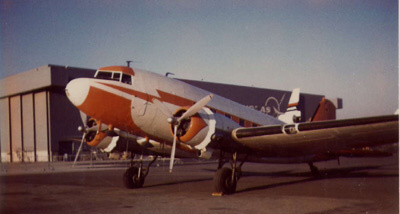 |
| Pacific Northern Airlines only airplane |
We leased a Cessna 172 for me to
use and I started planning routes, meeting people in the cities where I hoped
to stop, gave talks to civic groups and in general, acted like an executive.
My idea was to service Oregon with flights to their major cities, fly mail and
film and freight etc. My headquarters was in Salem, the state capital.
I thought that we were progressing
quite well. I had purchased a wide door DC-3 and it was certified, the manuals
were coming along when the other two officers and myself held a meeting and
they wanted me to move the operation to Portland OR. and to only fly a shuttle
type operation between Portland and Seattle WA.
This was kind of ridiculous since
there were numerous jet flights on that route. The other major problem was
money. It was very difficult to meet the payroll each month, pay the phone,
aircraft lease, etc. etc. We held a vote and the result was two to one so
again, I was out of a job.
They ended up hiring 60 people to
be supported by one aircraft. They were also lucky in that an investor showed
up with 1 Million dollars to see them through. They were certified several
months later and started the shuttle flights. On the first day they had three
passengers, on the second day they had one passenger and on the third day went
'Belly Up'. An interesting interlude for me.
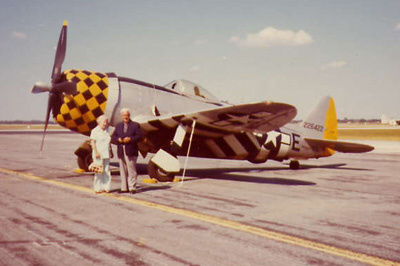

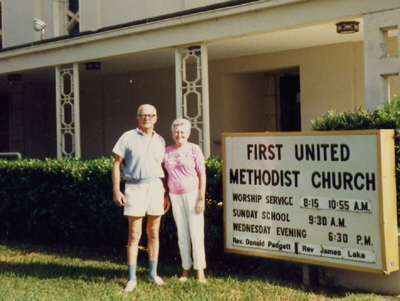
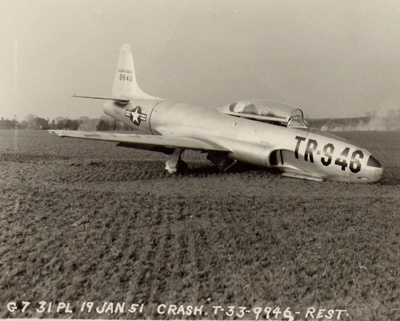
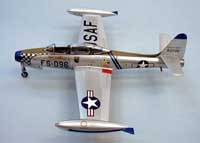


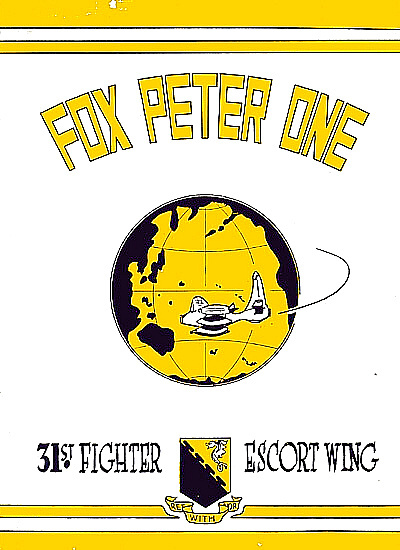
![Virgil I. Sansing [my saviour] and I when we flew a Japanese KATE](flying10s.jpg)











